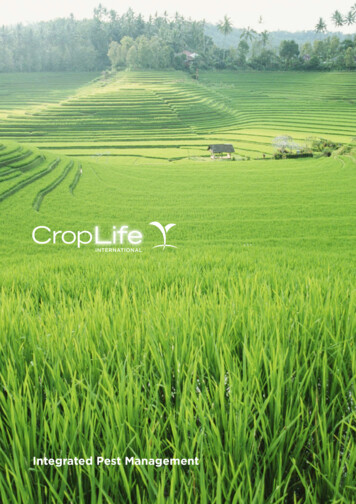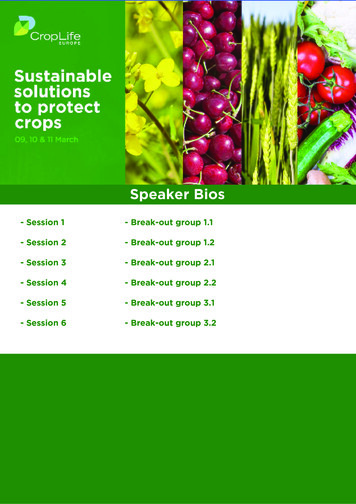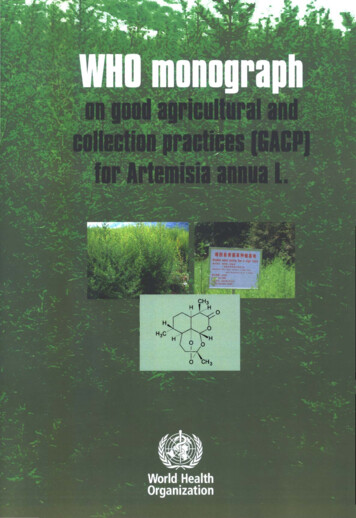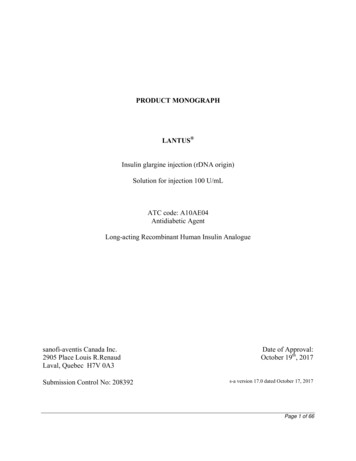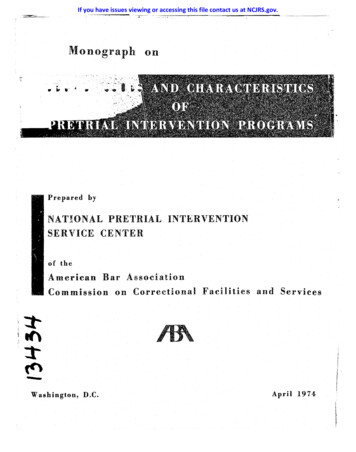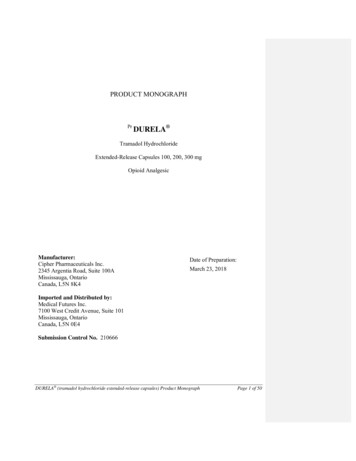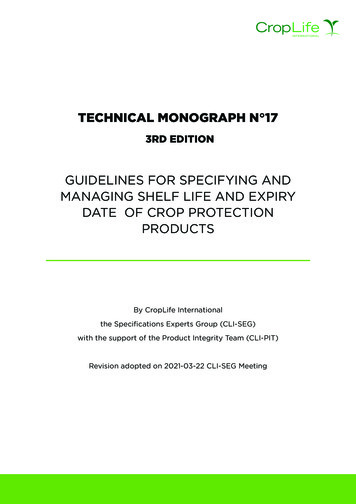
Transcription
TECHNICAL MONOGRAPH N 173RD EDITIONGUIDELINES FOR SPECIFYING ANDMANAGING SHELF LIFE AND EXPIRYDATE OF CROP PROTECTIONPRODUCTSBy CropLife Internationalthe Specifications Experts Group (CLI-SEG)with the support of the Product Integrity Team (CLI-PIT)Revision adopted on 2021-03-22 CLI-SEG Meeting
Contents1. INTRODUCTION. 32. PURPOSE AND SCOPE. 34. SHELF LIFE OF A PRODUCT AND ITS ASSOCIATED BATCH EXPIRY DATE. 45. SHELF LIFE AND FITNESS FOR USE. 55.1. Active ingredient(s) content. 55.2. Relevant impurities. 55.3. Physical properties. 55.4. Packaging. 56.1. Accelerated storage tests according to CIPAC MT 46.4. 66.2. Real time storage tests. 66.3. Low temperature storage tests. 77. GENERATING DATA FOR ASSIGNING A SHELF LIFE . 77.1. Establishing the Shelf Life of a new product. 77.2. Extending Shelf Life and Setting a new Batch Expiry Date. 87.3. Setting a new Expiry Date for a product batch in the market channel. 108. SUITABILITY OF PACKAGING MATERIALS. 118.1. Different types of packaging materials. 118.2. Testing compatibility and stability of packaging materials. 129. CHANGE OF FORMULATIONS DURING PRODUCT LIFE CYCLE. 1410 REFERENCES. 1511. GLOSSARY. 17Appendix 1: Options to establish the Shelf Life of CPPs (examples). 19
1. INTRODUCTIONCrop Protection Products (CPPs) are designed to be stable and fit for use when storedaccording to label instructions for a defined period (Shelf Life). During development,manufacturers routinely conduct both accelerated storage tests at elevatedtemperatures and real time storage tests at ambient temperatures to determine thestability of their products.To register a CPP, relevant stability data must be submitted to the competentauthorities. Depending on country specific regulations, registration can be grantedbased on stability data from accelerated storage tests meeting the data requirements.In some countries, stability data from real time storage tests are additionally requiredto achieve registration. Based on the submitted stability data a Regulatory Shelf Life isgranted for the CPP.When setting and managing the Expiry Date of a batch, the Regulatory Shelf Life ofthe product must be respected.2. PURPOSE AND SCOPEThe purpose of this Technical Monograph is to provide guidance to all manufacturersof CPPs for establishing a Regulatory Shelf Life based on stability data and managingthe Batch Expiry Date of products in their final sales pack.All CPPs are in scope. The principles of this monograph may be also applied tobiological, biocidal or products for animal or public health such as vector controlproducts, though some requirements may differ.3. BACKGROUNDConditions during storage and transport may affect the stability and quality of aCPP through changes of physical properties (e.g. separation of multi-phase systems,thickening, claying, particle size increase, etc.), degradation of the active ingredient(s)or interaction with the packaging material.Therefore, the climatic conditions under which products are likely to be transportedand stored must be considered, especially where CPPs are distributed globally.Stability tests can be carried out under conditions simulating different climate zones.For liquid products additional low temperature studies may be required.Any Shelf Life claim made by a manufacturer shall be supported by studiesdemonstrating the stability of the product for the claimed Shelf Life period.It is already common practice that a CPP which was not applied during the currentgrowing season can be used in the following season, i.e. before the product is 2 yearsold. Nevertheless, from a quality point of view, many products remain fit for use muchlonger and can thus be still applied in subsequent seasons.When CPPs are intended to be used after the assigned Expiry Date, they should beretested before expiry to decide on their continued fitness for use and to set a newExpiry Date, provided country specific regulations allow this practice.Page: 3
4. SHELF LIFE OF A PRODUCT AND ITS ASSOCIATEDBATCH EXPIRY DATEIt is important to carefully distinguish two technical terms which often are used in thesame context: Shelf Life (period of time) Expiry Date (point in time)The Shelf Life of a CPP is a property indicating the period in which a CPP is fit for use.Any shelf life statement shall be supported by appropriate stability data.The Expiry Date of a batch is a property defined for a particular batch. Setting anExpiry Date is an operational task and is done at manufacturing level at time of thebatch release. The period between batch release and Expiry Date cannot be longerthan the Shelf Life.Note: The Shelf Life is established for a formulated product in general (including itspackaging) and applies to all its manufactured batches, whereas the Expiry Date isalways related to a particular batch of a formulated product.Regulatory Shelf Life (Regulatory task)Batch Expiry Date (Operational task)Figure 1: Distinguishing Regulatory Shelf Life and Batch Expiry Date (example)[1]: For definition of Starting Date see GlossaryPage: 4
5. SHELF LIFE AND FITNESS FOR USEDuring storage, CPPs may undergo chemical and physical changes at a rate whichdepends on the nature of its active ingredient(s), co-formulants, formulation type,packaging material and storage conditions. The product remains fit for use if changeshave no negative impact on its applicability, biological performance and operator-,consumer- or environmental safety. An essential condition for fitness for use of a CPPis its compliance with the registration during the whole Shelf Life. In general, productsare expected to meet requirements as outlined in the FAO/WHO manual(1). For somecountries, regulatory requirements provide limits for the content of active ingredient(s)or toxicologically relevant impurities as well as for key physical properties of theproduct.5.1. Active ingredient(s) contentThe manufacturer must ensure that at the time of release all batches fulfil thespecification and that the average active ingredient(s) content during a productioncampaign complies with the declared content. Unless country specific requirementsapply, all batches must be within the tolerance range for the active ingredient(s) asdefined in the FAO/WHO manual (1) and CropLife Technical Monograph no. 1 (2).Typically, a relative deviation of /-10% from the declared active ingredient content willnot significantly influence the biological efficacy of a CPP.For analysis of the content of active ingredients, validated company internal methodsor published methods, e.g. by CIPAC (3) when available, can be used.5.2. Relevant impuritiesWhere applicable, the manufacturer must ensure that the content of relevantimpurities does not exceed the allowed registered limit(s).For analysis of the content of relevant impurities, validated company internal methodsor published methods, e.g. by CIPAC when available, can be used.5.3. Physical propertiesFor most key formulation types, the FAO/WHO manual provides guidance on thephysical parameters required to be tested before and after storage. The formulationshall comply with relevant limits to ensure that the formulation can be handled andapplied without difficulties during the entire Shelf Life.The determination of physical properties should be based on CIPAC methods or otherinternational methods. Where company internal methods are used, this should bejustified.5.4. PackagingThe effect of the formulation on the packaging material and vice versa is importantand information on the compatibility of the packaging material is required. Commercialsales packs (finished product containers) made of plastic materials also have an ExpiryDate.Page: 5
6. DIFFERENT TYPES OF STORAGE STUDIESIn order to define and support the Shelf Life of a CPP, different types of stabilitystudies can be performed. Guidance on the required tests that need to be performedbefore and after storage is given by the relevant clauses of the FAO/WHO manual.Note: It is recommended that a storage test is conducted on a single batch offormulation in the commercial sales pack material or an equivalent one.The different types of stability studies are outlined in the following.6.1. Accelerated storage tests according to CIPAC MT 46.4Accelerated storage tests at elevated temperatures are performed to generateinformation on the expected Shelf Life relatively quickly. Accelerated storage testsinvolve extrapolation from higher to lower temperatures and from shorter to longerstorage periods. Since formulations are complex mixtures and higher temperaturescan induce a degradation pathway that may not exist at lower temperatures, there isuncertainty involved in such extrapolations, unless the formulation proves to be stableafter real time storage at ambient conditions.At the initial stage of a registration process a complete set of real time data is usuallynot available. In this case data from accelerated storage tests can be used to supportregistration. This approach is accepted in many countries, however, for some countriesdata from real time storage tests at ambient temperature are additionally required.Different storage regimes as defined in CIPAC MT 46.4 and referred to in the FAO/WHO manual can be used to perform accelerated storage tests. The listed alternativeconditions (2 weeks / 54 C, 4 weeks / 50 C, 6 weeks / 45 C, 8 weeks / 40 C, 12 weeks/ 35 C, 18 weeks / 30 C) are accepted as equivalent.If no significant chemical, physical or packaging changes occur in the acceleratedstorage test the CPP is expected to meet the specification after 2 years storage atambient conditions. However, if significant changes are observed, real time data atambient conditions may be needed to support a Shelf Life claim.Note: The purpose of accelerated storage tests is to extrapolate from highertemperature data after short term storage to lower temperature data after long termstorage, according to the Arrhenius equation.6.2. Real time storage testsIn contrast to accelerated storage tests, real time testing does not rely on extrapolationand therefore is always acceptable for the declaration of a Shelf Life. Storage is usuallyperformed at ambient temperature for at least 2 years or longer and the formulationmust meet the specified limits at the end of the stated storage period.Storage tests can be carried out at constant temperature under controlled laboratoryconditions or e.g. in a warehouse where the temperature is recorded during the testperiod and reported. Depending on country specific regulations, stability tests mayneed to be conducted at defined temperatures reflecting the respective climate zone.In the absence of such regulatory guidance it is suggested to perform stability studiesat ambient temperatures or under controlled condictions at e.g. 20 C 2 C or25 C 2 C.Page: 6
The following ranges of annual average temperatures are considered typical fordifferent climate zones: moderate climate:18 - 22 C hot climate:23 - 27 C very hot climate:28 - 31 C6.3. Low temperature storage testsCold temperatures may impact physical properties of certain formulation types e.g.due to crystallization of the active ingredient(s) or separation of multi-phase systems.For liquid products, the FAO/WHO manual requires low temperature storage testsaccording to CIPAC MT 39.3. After storage the product shall continue to comply withthe relevant clauses listed in the FAO/WHO manual in section 4.6.1 “Stability at 0 C”.7. GENERATING DATA FOR ASSIGNING A SHELF LIFE7.1. Establishing the Shelf Life of a new productData must be generated on physical, chemical and technical properties before andafter storage as well as on packaging compatibility.According to some guidelines, interim data (e.g. 6, 9, 12 or 18 months) of formulatedproducts may be required, e.g. where a formulation is expected to have a Shelf Life ofless than 2 years.Where a Shelf Life longer than
Note: It is recommended that a storage test is conducted on a single batch of formulation in the commercial sales pack material or an equivalent one. The different types of stability studies are outlined in the following. 6.1. Accelerated storage tests according to CIPAC MT 46.4 Accelerated storage tests at elevated temperatures are performed to generate information on the expected Shelf Life .
